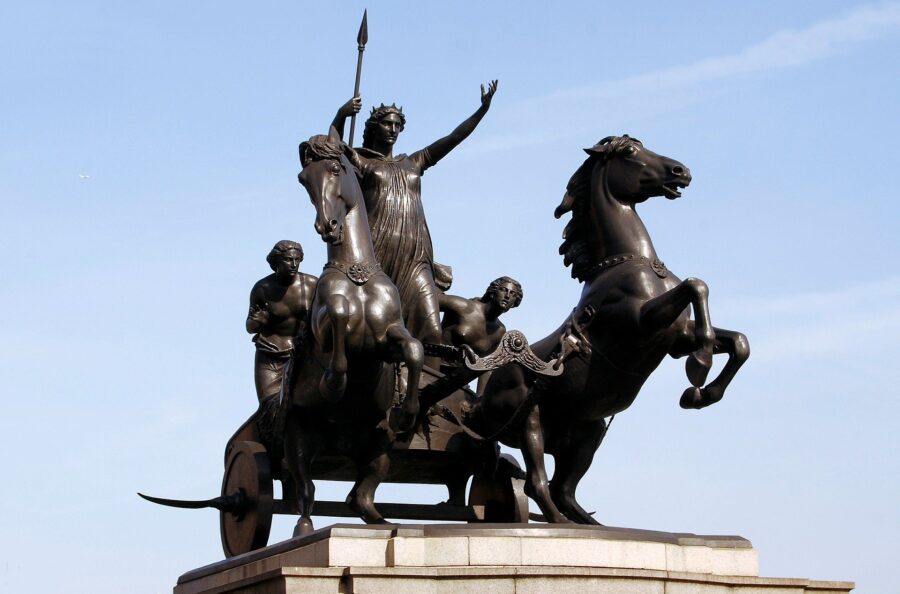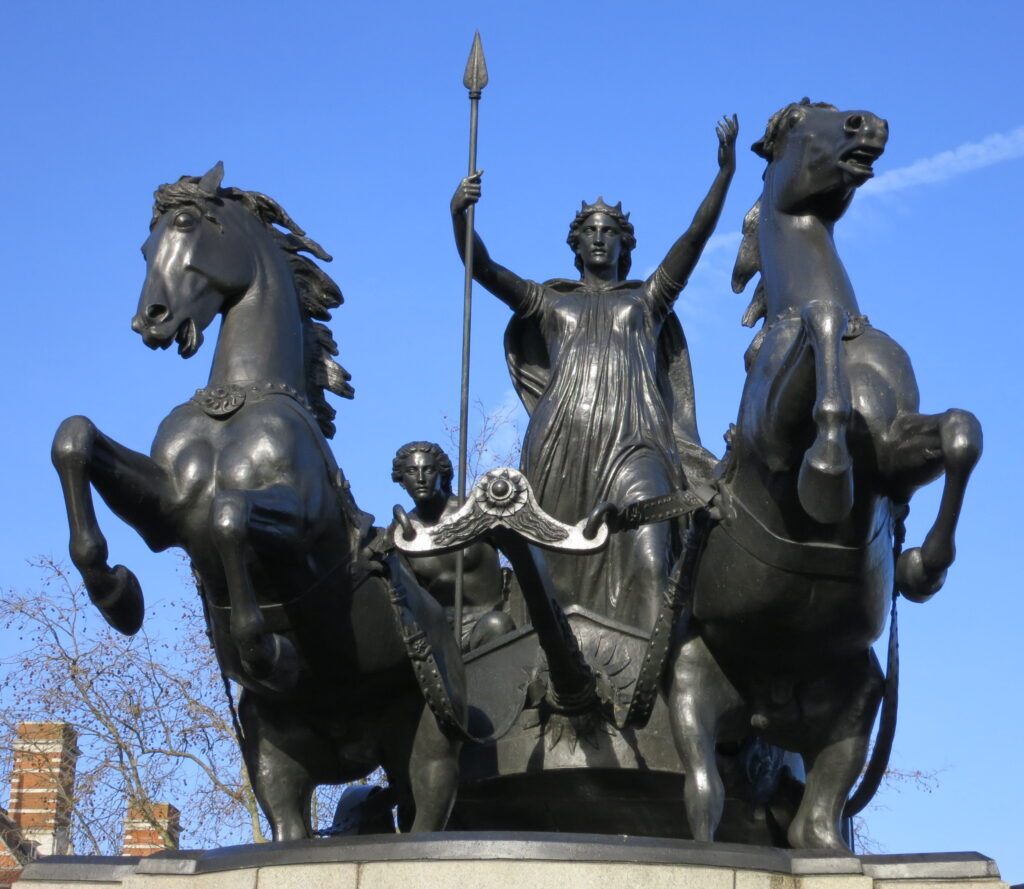
WHAT: Boudicca / Boadicea and her Daughters
WHERE: Westminster Embankment (map)
BY WHOM: Thomas Thorneycroft
WHEN: 1902
Boudicca* (sometimes Boudica) was, according to the Roman historian Tacitus, the leader of the largest revolt against Roman rule in around 60CE.
She was queen of the Iceni, a tribe whose homelands covered what is now the East Anglia county of Norfolk. The king (and her husband) was Prasutagus; after some resistance to the invasion he acknowledged Roman rule, but was maintained as a client ruler. This was a common practice of the Roman Empire (and later of the British), drawing the existing power structures into the imperial project, enabling control over territory without needed huge numbers of imperial troops.
When such a client died, his lands were meant to pass to the Emporer, but on his death, Prasutagus wanted to divide control between the Romans and his wife. Women could not inherit in the Empire and the procurator of the new province of Britannia seized all the lands for Rome, and (according to Tacitus) had Boudicca flogged and her daughters raped.
This assault caused Boudicca to lead the Iceni in revolt against the Romans. Joined by the neighbouring Trinovantes tribe they destroyed the provincial capital of Cochester (Camulodunum), marched on London and razed that town, slaughtering all the inhabitants who had not fled. The rebellious Brits then turned north to burn St Albans (Verulamium).
The main Roman force in Britain was otherwise occupied in Angelsey in North Wales, but on hearing the news of the attacks (and the rebels massacre of the Roman IX Legion, who had been sent to put down the rebellion), marched south.
Although outnumbered, the Romans’ superior weapons, tactics and dicipline were far too much for the Britons – tens of thousands were said to have been killed for the loss of a few hundred imperial soldiers. Boudicca is said to have taken poison. (Although there is no evidence about how she died or – and here’s the twist – whether she actually existed at all. Our sole source for much of the story is Tacitus, who was a child at the time these events took place. No archeological evidence for the existence of Boudicca has yet been found.)
A myth grew up that this final battle took place at Battle Bridge – modern day King’s Cross – but it is much more probable that the actual site was somewhere in the south midlands, close by Watling Street. And even more fantastic (in both sense of the word) urban myth has the grave of Boudicca underneath platforms 9 and 10 of King’s Cross station.
Boudicca started becoming an icon from the late 17th century, and particularly during the 18th, not uncoincidentally when Britain was expanding its own empire. The promotion of the warrior queen can probably be seen as the elevating of a ‘British spirit’, a bit of historical gloss intending to show that Britons have always fought for their liberties and refuse to accept tyranny. (Don’t @ me.)

The statue above was nearly 50 years in the making, or, rather, between commission and casting.
Unveiled in 1902, its story goes back to the Great Exhibition of 1851 when the sculptor Thomas Thorneycroft unveiled a plaster equestrian statue of Queen Victoria. Much impressed, Prince Albert was involved in commissioning this monumental Boudicca structure to stand above Decimus Burton’s ‘screen’ entrance to Hyde Park. (‘Boudicca’ in the britonnic language of the first century possibly means ‘victory’, as does, of course, ‘Victoria’. The parallels of two strong queens at the head of a nation of fighting men is also not uncoincidental.)
Nothing came of this, and although Thorneycroft had completed the full size model by the time of his death in 1885, it was not until 1898 that the money for casting the bronze was forthcoming.
It stands on a granite plinth at the north end of Westminster Bridge, the group charging towards Big Ben, Boudicca’s arms raised, her partially undressed daughters seated behind her in the chariot. (Victorian prudery did not extend to ‘classical’ subjects; sculputral nakedness from the era adorns much of London.)
It is, then, a hangover of victorianism, both in style and in the message it transmits. One could say it is an icon of London, but it commemorates one who destroyed the city. Like much of what exists here, it is a compound of history and myth, of legend and backward projection, part of a national history that owes more to wishful thinking than to fact.
*Boudicca is the more accurate rendering of the classical text; the often-used Boadicea is based on a 17th century misprint.
